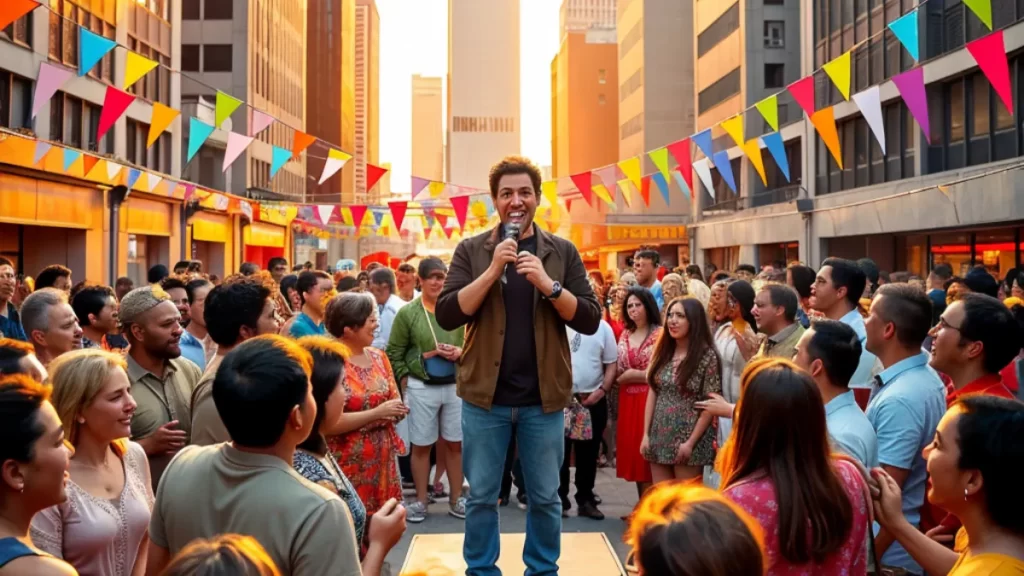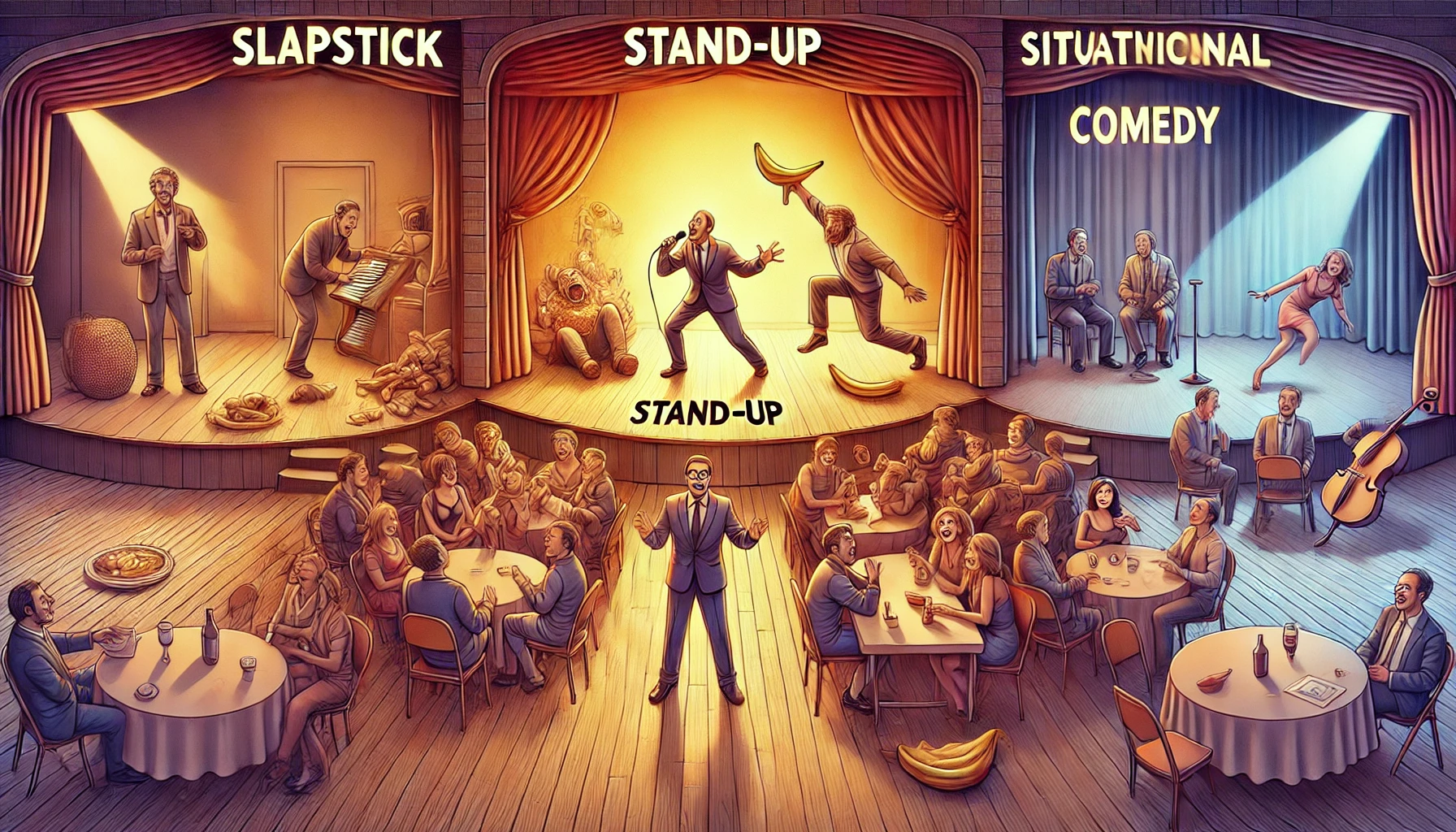Table of Contents
Comedy is a universal language that brings people together, making them laugh and forget their worries. But have you ever wondered what makes different styles of comedy so effective? In this article, we’ll explore the fascinating world of comedy, revealing the secrets behind various styles of comedy and why they have such a magical impact on audiences. Whether you’re a fan of stand-up, slapstick, or satire, this guide will offer you exciting insights and the latest updates on the world of humor.
The Classic Styles of Comedy
Comedy has evolved over the years, but some classic styles remain timeless. Let’s dive into a few of these enduring styles of comedy.
Slapstick Comedy
Slapstick comedy is all about physical humor. It’s a comedy type where exaggerated movements, falls, and silly situations create laughs. Styles of slapstick comedy often include absurd situations, artificial play, and ridicule, making it a light-hearted way to provide entertainment.
Think of Charlie Chaplin or the Three Stooges—comedians like them mastered this genre by employing comic elements, from ill-tempered nature to folly, to make audiences laugh. This style is also popular because it doesn’t rely on dialogue; like Charlie Chaplin, it’s enjoyed by people everywhere, regardless of language.
The definition of comedy, especially slapstick, often implies a foolish approach that makes fun of situations they find without any need for profound words. Slapstick is usually seen as a way to make light of events or conditions that ail the world. It includes characters playing off each other’s actions to create humor based on physical comedy.
It is an example of how classical conventions of humor have persisted, though comedies of Shakespeare also use classical rules to entertain audiences. In slapstick, three unities are thrown aside—anything goes for the sake of laughter.
Stand-Up Comedy
Stand-up comedy is another popular type of comedy, and many stand-up comics perform in front of a live audience, delivering jokes, stories, and observations.
This type includes various comedy styles, from observational comedy and deadpan to gallows humor. The genres of stand-up comedy are diverse, including improv comedy, situational comedies, and many different types of comedy shows.
As seen in sitcoms like “Seinfeld,” observational style often relies on humor that makes light of everyday life and situations they find themselves in. In contrast, more outrageous types like farcical or absurd comedy might remind you of movies like “The Hangover.”
Comedy appeals to audiences because humor is based on relatability, and stand-up comedians like Jim Carrey, Steven Wright, Anthony Jeselnik, or even Dave Chapelle often tap into this connection to catch the audience with plot twists and quick thinking.
These performances can be intricate, involving comedic performances that include everything from humor that makes audiences laugh at things to witty ridicule of ill-tempered nature, even to an almost wrath of the reformer type of criticism. Comedic performances often include popular types like physical comedy or improv, which people enjoy for spontaneous humor.
Comedy type also refers to the different genres, including slapstick, absurd humor, and situational comedies.
Stand-up is incredibly versatile; it often features different styles of stand-up comedy, ranging from more light-hearted material to something more biting and satirical, as seen with comedians like Borat or Jim Carrey.
In all these, the comedian’s ability to connect, adapt, and deliver makes comedy shows a dynamic art form. It’s not just about entertaining but also about making light of the absurdities of life.
Whether following classical conventions or creating something entirely new, the appeal of comedy is its ability to entertain audiences with laughter—simple, honest, and deeply human.
Modern Styles of Comedy
As times have changed, so have the styles of comedy. Today, new forms of humor have emerged, reflecting contemporary society.
Satire

Satire is a sophisticated style of comedy that uses humor to critique society, politics, and culture. Shows like “The Daily Show” or “Saturday Night Live” use satire to entertain while also making serious points. The secret to successful satire is its ability to balance humor with a message, making the audience laugh while also encouraging them to think critically about the world around them.
Improvisational Comedy
Improvisational comedy, or improv, is all about spontaneity. Comedians create scenes, characters, and jokes on the spot, often based on audience suggestions. The unpredictability of improv is what makes it so exciting. The best improv comedians are quick thinkers who can turn any situation into a funny one. This style of comedy thrives on the energy of the moment, making each performance unique.
The Impact of Comedy on Society
Comedy isn’t just about making people laugh; it also has a powerful impact on society. Different styles of comedy can influence social change, challenge norms, and bring attention to important issues.
Comedy as a Social Mirror
Comedy often reflects the society we live in. Through various styles of comedy, comedians hold up a mirror to our world, highlighting its absurdities, contradictions, and flaws. This reflection can lead to greater awareness and understanding among audiences, making comedy a tool for social change.
Breaking Down Barriers with Laughter
Laughter is a great equalizer. Different styles of comedy can break down barriers between people of different backgrounds, cultures, and beliefs. Whether it’s through the universal appeal of slapstick or the sharp wit of satire, comedy has the power to bring people together and foster a sense of shared humanity.
Also Read: If on a Winter’s Night a Traveler Unveils Hidden Mysteries
The Evolution of Comedy: What’s Next?

As we look to the future, it’s clear that comedy will continue to evolve. New styles of comedy will emerge, influenced by changing technologies, cultural shifts, and global events.
The Rise of Digital Comedy
The internet has revolutionized how we consume comedy. From viral videos to social media skits, digital platforms have given rise to new styles of comedy that are quick, shareable, and often interactive. As more comedians turn to these platforms, we can expect to see even more innovative and engaging forms of humor.
The Globalization of Comedy
Comedy is no longer confined to specific regions or cultures. Thanks to the internet and global media, different styles of comedy from around the world are now accessible to everyone. This globalization of comedy is leading to a cross-pollination of ideas and styles, resulting in a richer, more diverse comedic landscape.
Comedy is a dynamic and ever-evolving art form. From the timeless appeal of slapstick to the cutting-edge humor of digital platforms, different styles of comedy continue to entertain and inspire audiences worldwide. As we’ve explored in this article, the secrets behind the magic of laughter lie in the diversity of comedic styles, each with its unique way of connecting with audiences.

